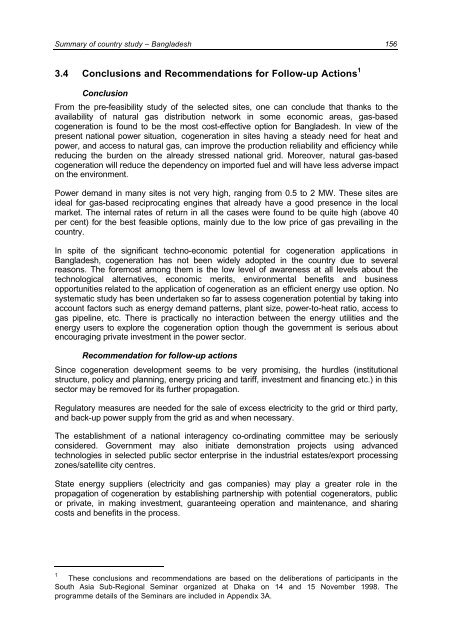part 1: overview of cogeneration and its status in asia - Fire
part 1: overview of cogeneration and its status in asia - Fire
part 1: overview of cogeneration and its status in asia - Fire
You also want an ePaper? Increase the reach of your titles
YUMPU automatically turns print PDFs into web optimized ePapers that Google loves.
Summary <strong>of</strong> country study – Bangladesh 156<br />
3.4 Conclusions <strong>and</strong> Recommendations for Follow-up Actions 1<br />
Conclusion<br />
From the pre-feasibility study <strong>of</strong> the selected sites, one can conclude that thanks to the<br />
availability <strong>of</strong> natural gas distribution network <strong>in</strong> some economic areas, gas-based<br />
<strong>cogeneration</strong> is found to be the most cost-effective option for Bangladesh. In view <strong>of</strong> the<br />
present national power situation, <strong>cogeneration</strong> <strong>in</strong> sites hav<strong>in</strong>g a steady need for heat <strong>and</strong><br />
power, <strong>and</strong> access to natural gas, can improve the production reliability <strong>and</strong> efficiency while<br />
reduc<strong>in</strong>g the burden on the already stressed national grid. Moreover, natural gas-based<br />
<strong>cogeneration</strong> will reduce the dependency on imported fuel <strong>and</strong> will have less adverse impact<br />
on the environment.<br />
Power dem<strong>and</strong> <strong>in</strong> many sites is not very high, rang<strong>in</strong>g from 0.5 to 2 MW. These sites are<br />
ideal for gas-based reciprocat<strong>in</strong>g eng<strong>in</strong>es that already have a good presence <strong>in</strong> the local<br />
market. The <strong>in</strong>ternal rates <strong>of</strong> return <strong>in</strong> all the cases were found to be quite high (above 40<br />
per cent) for the best feasible options, ma<strong>in</strong>ly due to the low price <strong>of</strong> gas prevail<strong>in</strong>g <strong>in</strong> the<br />
country.<br />
In spite <strong>of</strong> the significant techno-economic potential for <strong>cogeneration</strong> applications <strong>in</strong><br />
Bangladesh, <strong>cogeneration</strong> has not been widely adopted <strong>in</strong> the country due to several<br />
reasons. The foremost among them is the low level <strong>of</strong> awareness at all levels about the<br />
technological alternatives, economic mer<strong>its</strong>, environmental benef<strong>its</strong> <strong>and</strong> bus<strong>in</strong>ess<br />
opportunities related to the application <strong>of</strong> <strong>cogeneration</strong> as an efficient energy use option. No<br />
systematic study has been undertaken so far to assess <strong>cogeneration</strong> potential by tak<strong>in</strong>g <strong>in</strong>to<br />
account factors such as energy dem<strong>and</strong> patterns, plant size, power-to-heat ratio, access to<br />
gas pipel<strong>in</strong>e, etc. There is practically no <strong>in</strong>teraction between the energy utilities <strong>and</strong> the<br />
energy users to explore the <strong>cogeneration</strong> option though the government is serious about<br />
encourag<strong>in</strong>g private <strong>in</strong>vestment <strong>in</strong> the power sector.<br />
Recommendation for follow-up actions<br />
S<strong>in</strong>ce <strong>cogeneration</strong> development seems to be very promis<strong>in</strong>g, the hurdles (<strong>in</strong>stitutional<br />
structure, policy <strong>and</strong> plann<strong>in</strong>g, energy pric<strong>in</strong>g <strong>and</strong> tariff, <strong>in</strong>vestment <strong>and</strong> f<strong>in</strong>anc<strong>in</strong>g etc.) <strong>in</strong> this<br />
sector may be removed for <strong>its</strong> further propagation.<br />
Regulatory measures are needed for the sale <strong>of</strong> excess electricity to the grid or third <strong>part</strong>y,<br />
<strong>and</strong> back-up power supply from the grid as <strong>and</strong> when necessary.<br />
The establishment <strong>of</strong> a national <strong>in</strong>teragency co-ord<strong>in</strong>at<strong>in</strong>g committee may be seriously<br />
considered. Government may also <strong>in</strong>itiate demonstration projects us<strong>in</strong>g advanced<br />
technologies <strong>in</strong> selected public sector enterprise <strong>in</strong> the <strong>in</strong>dustrial estates/export process<strong>in</strong>g<br />
zones/satellite city centres.<br />
State energy suppliers (electricity <strong>and</strong> gas companies) may play a greater role <strong>in</strong> the<br />
propagation <strong>of</strong> <strong>cogeneration</strong> by establish<strong>in</strong>g <strong>part</strong>nership with potential cogenerators, public<br />
or private, <strong>in</strong> mak<strong>in</strong>g <strong>in</strong>vestment, guarantee<strong>in</strong>g operation <strong>and</strong> ma<strong>in</strong>tenance, <strong>and</strong> shar<strong>in</strong>g<br />
costs <strong>and</strong> benef<strong>its</strong> <strong>in</strong> the process.<br />
1 These conclusions <strong>and</strong> recommendations are based on the deliberations <strong>of</strong> <strong>part</strong>icipants <strong>in</strong> the<br />
South Asia Sub-Regional Sem<strong>in</strong>ar organized at Dhaka on 14 <strong>and</strong> 15 November 1998. The<br />
programme details <strong>of</strong> the Sem<strong>in</strong>ars are <strong>in</strong>cluded <strong>in</strong> Appendix 3A.









